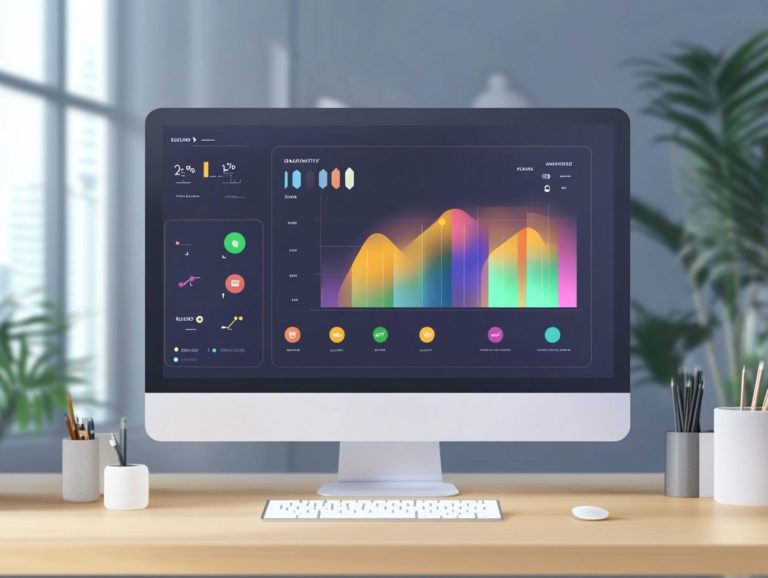Using Performance Management Tools to Drive Results
In today’s fast-paced work environment, effective performance management is crucial for unlocking employee potential and ensuring organizational success. Let’s explore how performance management can transform your workplace.
You’ll discover the benefits of using performance management tools and how they can significantly influence employee performance and drive results. From setting ambitious goals to establishing feedback mechanisms, we will explore various tools and best practices to maximize performance management efforts.
Dive in with us to uncover strategies that will elevate both individual and team performance, paving the way for sustainable success.
Contents
- Key Takeaways:
- Understanding Performance Management
- Benefits of Using Performance Management Tools
- Types of Performance Management Tools
- Implementing Performance Management Tools
- Maximizing Results with Performance Management Tools
- Common Questions About Performance Management Tools
- What are performance management tools and how can they drive results?
- What are some common examples of performance management tools?
- How can using performance management tools help improve employee productivity?
- In what ways can performance management tools benefit an organization’s bottom line?
- How can performance management tools be used to foster employee development?
- What are some best practices for using performance management tools effectively?
Key Takeaways:
- Performance management tools help organizations monitor and improve employee performance, leading to overall success.
- These tools come in various forms, such as goal-tracking and feedback systems, and significantly impact employee productivity and motivation.
- Consider factors like alignment with company goals and providing proper training when implementing performance management tools for maximum effectiveness.
Understanding Performance Management
Performance management involves organized methods tailored to enhance organizational success by aligning employee engagement, development opportunities, and performance measures with strategic business goals.
This varied process includes goal setting, performance reviews, and ongoing development, ensuring teams effectively work towards achieving individual and organizational aims.
Definition and Purpose
Performance management includes processes and systems implemented to boost employee performance and achieve organizational goals.
This comprehensive approach promotes ongoing feedback and development, aligning personal goals with team objectives. Effective performance management ensures employees feel valued and engaged in their work.
As a result, enhanced job satisfaction motivates employees to contribute meaningfully. Recognizing how individual efforts influence overall success fosters a sense of purpose and belonging, benefiting the organization’s health.
In this dynamic, both individual accomplishments and collective achievements become part of a shared journey toward future success.
Benefits of Using Performance Management Tools
Utilizing performance management tools presents various advantages that profoundly influence employee performance, enhance talent retention, and generate cost savings—all contributing to organizational success.
Impact on Employee Performance and Organizational Success
The impact of performance management tools on employee performance and organizational success is significant. They establish a culture of feedback that drives accountability and continuous improvement.
These tools provide a structured approach to measuring performance, clarifying expectations, and identifying areas for growth. Companies like Google and Salesforce exemplify this integration, employing performance management systems that track individual objectives while promoting collaborative team goals to boost productivity.
For instance, Google’s Objectives and Key Results (OKRs) methodology encourages employees to set ambitious targets, fostering innovation and engagement. Similarly, Salesforce’s real-time feedback feature enables immediate recognition and adjustments, cultivating a strong sense of ownership among employees and aligning their efforts with company goals.
These examples illustrate how leveraging performance management tools can significantly enhance your path to organizational success.
Types of Performance Management Tools
Various performance management tools streamline your goal-setting, tracking, and evaluation processes. These tools enhance employee engagement and overall performance, ensuring everyone is aligned and motivated.
Goal-Setting and Tracking Tools
Goal-setting and tracking tools are invaluable features of performance management software, allowing you to define, monitor, and achieve personal and team objectives with precision.
These tools clarify expectations and establish a structured framework. By adopting methodologies like OKRs, you can break down broader organizational goals into manageable, measurable tasks, ensuring all employees work towards a common vision while tracking progress.
Regular performance assessments using these tools promote accountability and support continuous improvement.
This helps your organization adapt to evolving dynamics while keeping your sights on your ultimate goals.
Feedback and Evaluation Tools
Feedback and evaluation tools are essential in performance management, providing quality insights and facilitating performance appraisals that enhance employee engagement and development.
These tools range from structured performance appraisals to 360-degree feedback systems, which gather insights from peers, managers, and subordinates. Each type serves a unique purpose, offering a comprehensive view of an employee’s strengths and areas for growth.
By utilizing these methods, you improve performance assessments and foster open dialogues between managers and their teams. Creating a culture of constructive feedback empowers employees, leading to increased morale and productivity.
Ultimately, effectively leveraging feedback mechanisms cultivates an environment where continuous improvement is valued and embraced.
Implementing Performance Management Tools
When implementing performance management tools, consider several key factors impacting employee retention and leadership behavior in your organization.
Key Factors to Consider
Key factors include strategic alignment with business objectives and establishing effective communication strategies to secure stakeholder buy-in.
Understanding this is crucial for a performance management system’s effectiveness, as it hinges on the clarity it brings to your organizational goals. Aligning each individual’s performance metrics with the overall business mission cultivates a culture of accountability and continuous improvement.
Effective communication strategies clarify expectations and create avenues for feedback and dialogue. This two-way interaction makes stakeholders feel valued and engaged, vital for building enthusiasm and commitment to achieve shared goals.
Maximizing Results with Performance Management Tools
To maximize results with performance management tools, embrace best practices that cultivate a culture of continuous improvement.
By doing so, you can effectively monitor performance trends and ensure your organization remains on the path to success.
Best Practices and Tips
Implementing best practices in performance management is crucial for motivating employees and establishing effective reward systems that recognize achievements.
Utilize a blend of regular feedback mechanisms, goal-setting frameworks, and recognition programs to foster an environment where employees feel valued and inspired to excel. Encouraging open lines of communication allows for real-time discussions, significantly boosting morale and engagement.
Use data-driven insights to create rewards that align with individual aspirations, boosting job satisfaction and retention rates. A holistic approach evaluates individual contributions while promoting continuous improvement and teamwork.
Common Questions About Performance Management Tools
What are performance management tools and how can they drive results?
Performance management tools help organizations track employee performance, providing valuable insights that improve decision-making and results.
What are some common examples of performance management tools?
Common examples include goal-setting software, review platforms, feedback systems, and recognition programs.
How can using performance management tools help improve employee productivity?
These tools set clear goals, provide feedback, and recognize achievements, motivating employees and boosting productivity.
In what ways can performance management tools benefit an organization’s bottom line?
These tools identify top performers and areas for improvement, leading to better resource utilization and enhanced financial performance.
How can performance management tools be used to foster employee development?
These tools track employee progress, highlight training needs, and encourage regular check-ins between employees and managers to set and review goals.
What are some best practices for using performance management tools effectively?
Best practices include setting clear goals, providing regular feedback, involving employees in the process, and using data to drive improvement.

.jpg_00.jpeg)
.jpg_01.jpeg)
.jpg_10.jpeg)
.jpg_11.jpeg)




